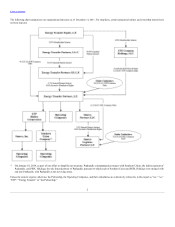Energy Transfer 2013 Annual Report Download - page 10
Download and view the complete annual report
Please find page 10 of the 2013 Energy Transfer annual report below. You can navigate through the pages in the report by either clicking on the pages listed below, or by using the keyword search tool below to find specific information within the annual report.
Table of Contents
segment, we directly own and operate approximately 12,800 miles of interstate natural gas pipeline with approximately 11.3 Bcf/d of transportation capacity
and have a 50% interest in the joint venture that owns the 185-mile Fayetteville Express pipeline. ETP also owns a 50% interest in Citrus which owns 100% of
FGT, an approximately 5,400 mile pipeline system that extends from south Texas through the Gulf Coast to south Florida.
Our interstate transportation and storage segment includes Panhandle, which owns and operates a large natural gas open-access interstate pipeline
network. The pipeline network, consisting of the PEPL, Trunkline and Sea Robin transmission systems, serves customers in the Midwest, Gulf Coast and
Midcontinent United States with a comprehensive array of transportation and storage services. In connection with its natural gas pipeline transmission and
storage systems, Panhandle has five natural gas storage fields located in Illinois, Kansas, Louisiana, Michigan and Oklahoma. Southwest Gas operates four
of these fields and Trunkline operates one.
As discussed above in “Significant Organic Growth Projects,” we are currently developing plans to convert a portion of the Trunkline gas pipeline to crude oil
transportation.
The results from our interstate transportation and storage segment are primarily derived from the fees we earn from natural gas transportation and storage
services. The major customers on our interstate pipelines include BG Energy Holdings Ltd., Chesapeake Energy Marketing, Inc., Ameren Corporation,
EnCana Marketing (USA), Inc., and Petrohawk Energy Corporation.
Midstream Segment
The midstream natural gas industry is the link between the exploration and production of natural gas and the delivery of its components to end-use markets.
The midstream industry consists of natural gas gathering, compression, treating, processing and transportation, and is generally characterized by regional
competition based on the proximity of gathering systems and processing plants to natural gas producing wells.
The natural gas gathering process begins with the drilling of wells into gas-bearing rock formations. Once a well has been completed, the well is connected to a
gathering system. Gathering systems generally consist of a network of small diameter pipelines and, if necessary, compression systems, that collects natural
gas from points near producing wells and transports it to larger pipelines for further transportation.
Gathering systems are operated at design pressures that will maximize the total throughput from all connected wells. Specifically, lower pressure gathering
systems allow wells, which produce at progressively lower field pressures as they age, to remain connected to gathering systems and to continue to produce for
longer periods of time. As the pressure of a well declines, it becomes increasingly difficult to deliver the remaining production in the ground against a higher
pressure that exists in the connecting gathering system. Field compression is typically used to lower the pressure of a gathering system. If field compression is
not installed, then the remaining production in the ground will not be produced because it cannot overcome the higher gathering system pressure. In contrast, if
field compression is installed, then a well can continue delivering production that otherwise might not be produced.
Natural gas has a varied composition depending on the field, the formation and the reservoir from which it is produced. Natural gas from certain formations is
higher in carbon dioxide, hydrogen sulfide or certain other contaminants. Treating plants remove carbon dioxide and hydrogen sulfide from natural gas to
ensure that it meets pipeline quality specifications.
Some natural gas produced by a well does not meet the pipeline quality specifications established by downstream pipelines or is not suitable for commercial
use and must be processed to remove the mixed NGL stream. In addition, some natural gas produced by a well, while not required to be processed, can be
processed to take advantage of favorable processing margins. Natural gas processing involves the separation of natural gas into pipeline quality natural gas, or
residue gas, and a mixed NGL stream.
Through our midstream segment, we own and operate approximately 6,700 miles of in service natural gas and NGL gathering pipelines with approximately
6.0 Bcf/d of gathering capacity, 5 natural gas processing plants, 15 natural gas treating facilities and 3 natural gas conditioning facilities with an aggregate
processing, treating and conditioning capacity of approximately 4.2 Bcf/d. Our midstream segment focuses on the gathering, compression, treating, blending,
and processing, and our operations are currently concentrated in major producing basins and shales, including the Austin Chalk trend and Eagle Ford Shale
in South and Southeast Texas, the Permian Basin in West Texas and New Mexico, the Barnett Shale and Woodford Shale in North Texas, the Bossier Sands
in East Texas, the Marcellus Shale in West Virginia, and the Haynesville Shale in East Texas and Louisiana. Many of our midstream assets are integrated
with our intrastate transportation and storage assets.
Our midstream segment results are derived primarily from margins we earn for natural gas volumes that are gathered, transported, purchased and sold
through our pipeline systems and the natural gas and NGL volumes processed at our processing and treating facilities. The major customers on our midstream
pipelines include Enterprise Products Operating LLC, ONEOK Hydrocarbon, L.P., Formosa Hydrocarbons Company, Inc., Chevron Phillips Chemical
Company LP, and Phillips 66 Company.
5























